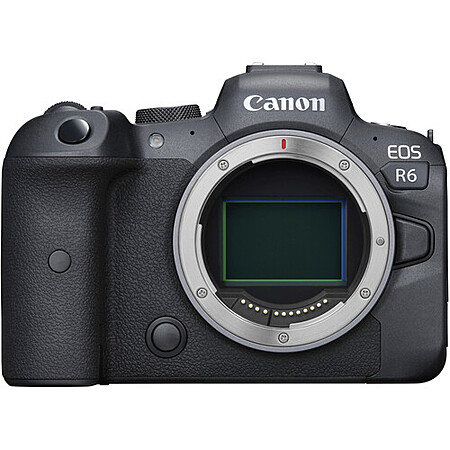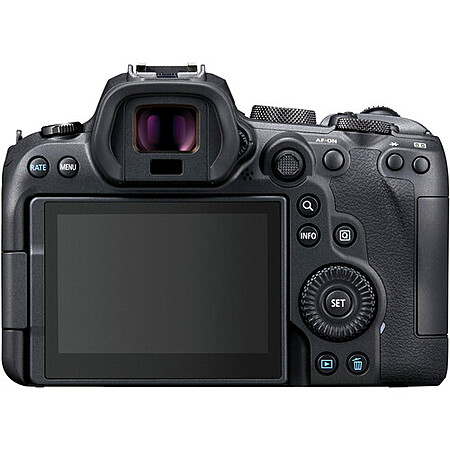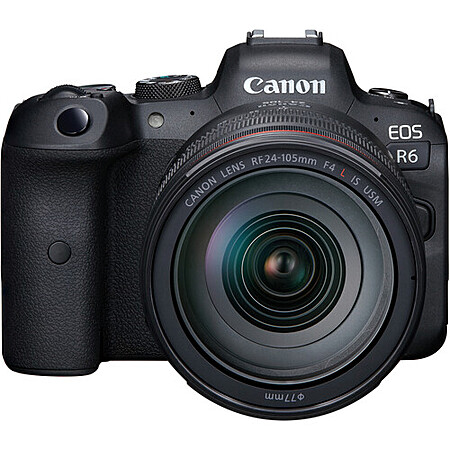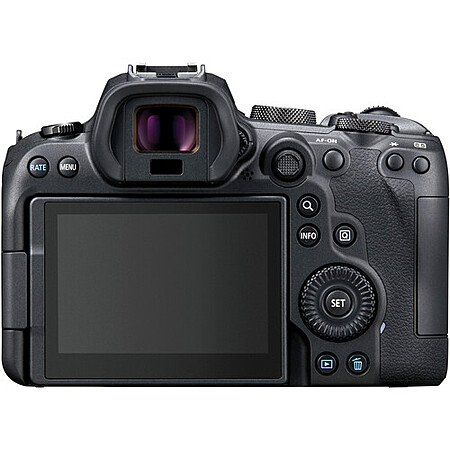| Product Description: | Full-Frame Mirrorless Camera for Photographers and Video Content Creators
Delivering incredible performance at speeds up to 12 fps, the EOS R6 camera from Canon can capture the split-second details between a subject's movements. This is great for dynamic action photos of athletes, animals, or vehicles in motion. The selectable electronic (silent) shutter mode can capture images at up to 20 fps, which is useful for wildlife photographers and photojournalists.
20MP Full-Frame Sensor and DIGIC X Processor
Built around a revised 20MP full-frame CMOS sensor, the EOS R6 offers modest resolution to complement a more manageable workflow, especially for those working with the web and small print forms as their final output. This sensor is paired with a fine-tuned DIGIC X image processor, which enables impressive stills and video capabilities, along with sensitivity from ISO 100-102400, which can be expanded up to ISO 204800.
4K60 and Full HD 120 Video Recording
Beyond stills, the 20MP sensor also affords UHD 4K video recording at up to 60 fps, along with Full HD at 120 fps for slow-motion playback. Both formats can be recorded internally at 4:2:2 10-bit and both Canon Log and HDR-PQ are supported for greater control over color rendering, and to suit high dynamic range output. Additionally, Dual Pixel CMOS AF is supported for all recording settings and external recording, via the HDMI port, enables clean 4K output to an optional external recorded.
Dual Pixel CMOS AF II
An updated Dual Pixel CMOS AF II features 1053 selectable focusing points, which cover approximately 100% of the image frame for wide and even coverage. This focusing system offers smooth and fast focusing performance in a similar manner to how a camcorder acquires focus. The system integrates two separate photodiodes within each pixel to provide a broad and dense network of phase-detection gathering elements across a majority of the image sensor to reduce focus hunting for faster, more direct control of focus placement. When working with still imagery, this |
| Product SKU: | 1547010 |
| 20mp_full-frame_cmos_sensor: | DIGIC X Image Processor |
| 4k60p_and_fhd_120p_10-bit_internal_video: | Sensor-Shift 5-Axis Image Stabilization |
| bulbtime_mode: | Bulb Mode |
| continuous_shooting: | Mechanical ShutterUp to 12 fps at 20 MP for up to 1000 Frames (JPEG) / 240 Frames (Raw)Electronic ShutterUp to 20 fps at 20 MP for up to 1000 Frames (JPEG) / 240 Frames (Raw) |
| exposure_compensation: | -3 to +3 EV (1/3, 1/2 EV Steps) |
| exposure_modes: | Aperture Priority, Auto, Manual, Program, Shutter Priority |
| interval_recording: | Yes |
| iso_sensitivity: | Photo100 to 102,400 in Auto Mode (Extended: 100 to 204,800)Video100 to 25,600 (Extended: 100 to 204,800) |
| metering_method: | Center-Weighted Average, Evaluative, Partial, Spot |
| metering_range: | -3 to 20 EV |
| self-timer: | 2/10-Second Delay |
| shutter_speed: | Mechanical Shutter1/8000 to 30 Seconds Electronic Front Curtain Shutter1/8000 to 30 Seconds Electronic Shutter1/8000 to 0.5 Seconds |
| shutter_type: | Electronic Shutter, Mechanical Focal Plane Shutter |
| white_balance: | Presets: Auto, Cloudy, Color Temperature, Custom, Daylight, Flash, Fluorescent (White), Shade, Tungsten |







Leave a Comment
Top Comments
Upgrading from my RP to R6 was night and day in terms of dynamic range and high ISO performance out of the sensors.
Then, comparing ehutter readout speeds was another drastic difference. My RP suffered from rolling shutter 80% of the time, my R6 almost never, and a body like the Z9 almost eliminates rolling shutter entirely (hence the lack of a mechanical shutter).
Comparing my R6 with my buddies a7rIII look darn good at first glance but if I have to do anything more than a modest crop the difference is quite large.
If all you are doing is SOOC jpgs in proper lighting and using the finished product as is, sure they all look the same.
But if you try and do anything demanding whether it be low light, high dynamic range, eshutter, heavy cropping, etc there are certainly still big differences between sensors.
That doesn't even take into account advances in AF tech, subject tracking, burst speeds, ergonomics, button layouts, I/O features, screen performance, write speeds, etc. Which all matter just as much as image quality.
For video work, the R6 is actually better than the R5. (No 8K given the 20 Mpxl sensor, but most will be very happy with 4K, even in 2025 and beyond.)
Use your PayBoo credit card to buy from B&H and pay NO TAX!
79 Comments
Sign up for a Slickdeals account to remove this ad.
Our community has rated this post as helpful. If you agree, why not thank 11A
For video work, the R6 is actually better than the R5. (No 8K given the 20 Mpxl sensor, but most will be very happy with 4K, even in 2025 and beyond.)
Use your PayBoo credit card to buy from B&H and pay NO TAX!
The low megapixel is really the only downside on this camera, but unless you're blowing your pics up to big posters or doing very small cropping it shouldn't matter.
For video work, the R6 is actually better than the R5. (No 8K given the 20 Mpxl sensor, but most will be very happy with 4K, even in 2025 and beyond.)
Use your PayBoo credit card to buy from B&H and pay NO TAX!
Upgrading from my RP to R6 was night and day in terms of dynamic range and high ISO performance out of the sensors.
Then, comparing ehutter readout speeds was another drastic difference. My RP suffered from rolling shutter 80% of the time, my R6 almost never, and a body like the Z9 almost eliminates rolling shutter entirely (hence the lack of a mechanical shutter).
Comparing my R6 with my buddies a7rIII look darn good at first glance but if I have to do anything more than a modest crop the difference is quite large.
If all you are doing is SOOC jpgs in proper lighting and using the finished product as is, sure they all look the same.
But if you try and do anything demanding whether it be low light, high dynamic range, eshutter, heavy cropping, etc there are certainly still big differences between sensors.
That doesn't even take into account advances in AF tech, subject tracking, burst speeds, ergonomics, button layouts, I/O features, screen performance, write speeds, etc. Which all matter just as much as image quality.
Sign up for a Slickdeals account to remove this ad.
As much as I've enjoyed the EOS R, the best investment over time has been great glass. Now I can try to push non-IS and some IS lenses even further with the in-body stabilization. I've always enjoyed the Canon EF 24-70, but always found the lack of IS to be a limiting factor is some situations, having to take 10 shots in hopes of one or two coming out tack sharp when shooting slower than 1/100 or so.
Even with the smaller battery, one can purchase spare ones for cheap. The new/improved autofocus system appears to be quite a bit better with the R8 vs the R6. Plus the 40 FPS is a very nice feature.
R8 does not have a dual card slot.
Even with the smaller battery, one can purchase spare ones for cheap. The new/improved autofocus system appears to be quite a bit better with the R8 vs the R6. Plus the 40 FPS is a very nice feature.
R8 does not have a dual card slot.
Even with the smaller battery, one can purchase spare ones for cheap. The new/improved autofocus system appears to be quite a bit better with the R8 vs the R6. Plus the 40 FPS is a very nice feature.
R8 does not have a dual card slot.
Sign up for a Slickdeals account to remove this ad.
Leave a Comment